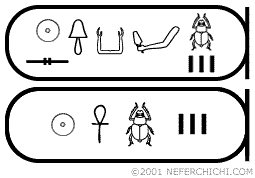The Pharaohs
Smenkhkare
Birth name: Smenkhkare Djeserkheperu ("Vigorous is the Soul of Re, Holy of Manifestations")
Throne name: Ankhkheperure ("Living are the Manifestations of Re")
Rule: 1336 - 1334 BC (11th king of the 18th dynasty, New Kingdom)
Noteworthy relatives: Merytaten (queen), Tutankhamun (brother), Akhenaten (father). [view family tree]
The controversial pharaoh Akhenaten had decided that all the gods of Egypt no longer existed– there was only one god, the Aten, and it was the sun itself. He abandoned Thebes for a brand-new capital city specially built for the Aten, and spent his days there writing poems to his exclusive god and basically ignoring all his pharaonic duties.
Back at Thebes, the public was growing resentful and uneasy. The vizier Ay urged Akhenaten to appoint a co-regent (another pharaoh to rule simultaneously) who would go back to Thebes and keep the people in line. Smenkhkare, who was probably one of Akhenaten's sons with a sister, was married to one of Akhenaten's daughters, Merytaten, and together they returned to Thebes to hopefully ease the escalating tensions.
The historical record gets a bit confusing here, because at around the same time Akhenaten's main queen Nefertiti is no longer mentioned and presumed dead. Then, within a just a couple years, Akhenaten, Smenkhkare, and Merytaten are all inexplicably dead too. The next person in line to inherit the throne was Smenkhkare's brother Tutankhaten, who was also the son of Akhenaten.

Unnamed royals believed to be Smenkhkare and his queen Merytaten. By Photo: Andreas Praefcke (Own work (own photograph)) [Public domain], via Wikimedia Commons
